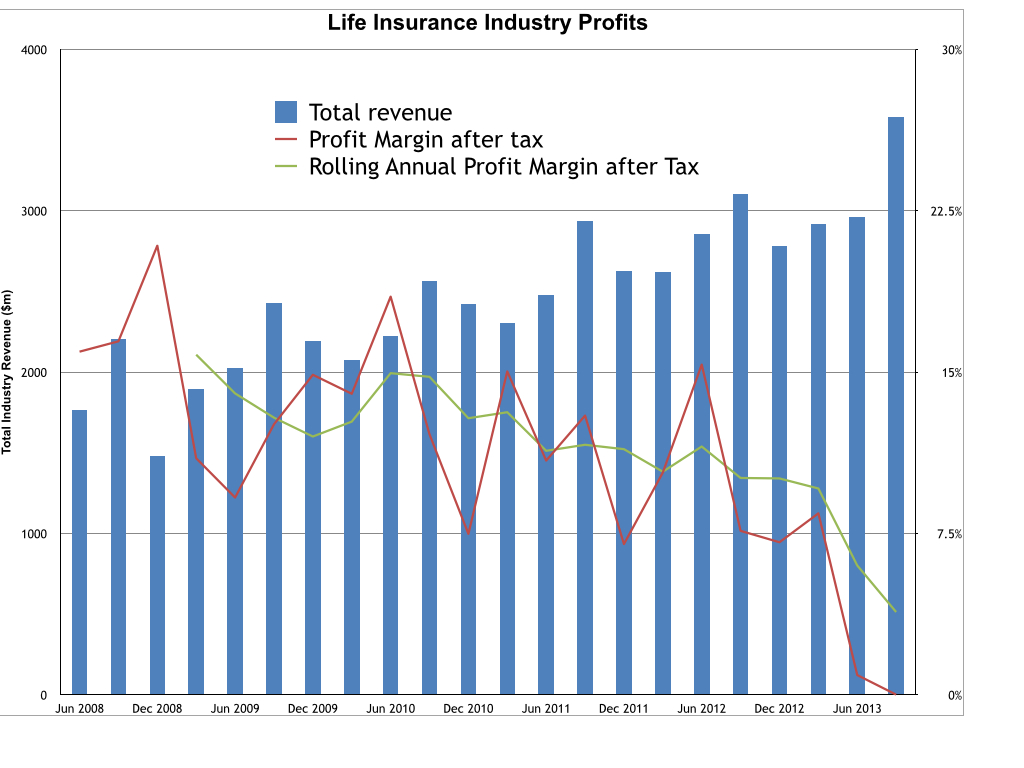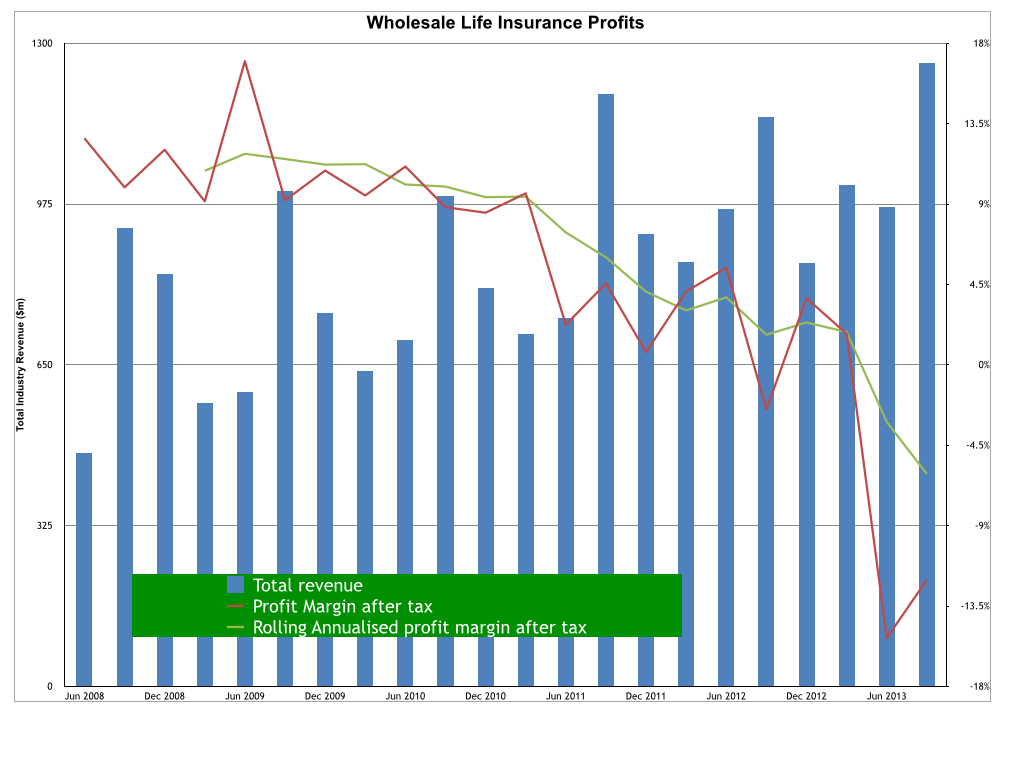A few months ago, I posted about some press actuaries had received about their crystal balls proving inadequate in the life insurance industry. Well the news hasn’t been getting any better.

Recent reports from two of Australia’s major life reinsurers have continued the bad news. Most recently, APRA released their quarterly statistics for the quarter ending September 2013, and commented on them in their quarterly update. Overall, the life insurance risk part of the life insurance industry has made 4% profit after tax, as a percentage of revenue in the last 12 months. Group Insurance (which generally insures corporate and industry superannuation funds) made a 6% loss after tax, over the last twelve months, as a percentage of revenue.

The life insurance industry is not making sustainable profits. And the news (financially) seems to be getting worse, not better, as insurer after insurer strengthens their reserves.
This hasn’t gone unnoticed in the actuarial profession, with much of the life insurance part of the recent risk and regulation seminar discussing the sustainability of the industry, and a whole lunchtime session recently devoted to Wholesale, or Group Insurance. The slides are worth reading in their entirety. The group session pointed out that there are a number of different issues affecting the group market at the same time.
The average insurance product within the group market as a whole has gradually weakened definitions (legally made the definitions of disability less stringent) at the same time as making it easier to qualify for insurance with little or no underwriting. Members have become increasingly aware that they have insurance, which is often driven by increased benefits. Lawyers have become more involved, as the benefits have become higher, and higher unemployment in some areas of the economy makes it much harder for disabled people to return to work.
Anyone who has been involved in long tail classes will recognise some of the symptoms of a classic insurance cycle; as profits increase, insurers relax terms and conditions and reduce prices . But then as claims start coming in, insurers realise they have given too much away, and tighten terms and conditions, increasing prices and reduce capacity. In my view, one of the major preconditions for the creation of insurance cycles is that there needs to be a reasonably long tail between the incidence of the claim and the payment, so that insurers can’t be definitive about the cost or profitability of the insurance cover they are selling for several years. That creates a feedback loop which takes some time to work its way through the system.
Don’t follow the herd
Insurers need to be prepared to walk away from markets when prices fall below a prudent, risk-based premium.Invest in the latest risk management tools
Insurers must push for continuous improvement of these tools based on the latest science around issues such as climate change, and make full use of them to communicate their pricing and coverage decisions.
Don’t let surplus capital dictate your underwriting
An excess of capital available for underwriting can easily push an insurer to deploy the capital in unsustainable ways, rather than having that capital migrate to other uses such as hedge funds and equities, or returning it to shareholders.Don’t be dazzled by higher investment returns
Don’t let higher investment returns replace disciplined underwriting as base rates creep up on both sides of the Atlantic. Notionally, splitting the business into insurance and asset management operations, and monitoring each separately, is one way to achieve this.Don’t rely on “the big one” to push prices upwards
The spectacular insured loss should not be used as an excuse to raise prices in unrelated lines of business. Regulators, rating agencies, and analysts – not to mention insurance buyers – are increasingly resisting such behaviour.Redeploy capital from lines where margins are unsustainable
There is little that individual insurers can do to alter overall supply-and-demand conditions. But insurers can set up internal monitoring systems to ensure that they scale back in lines in which margins have become unsustainable and migrate to other lines.Get smarter with underwriter and manager incentives
Incentives for key staff should be structured to reward efficient deployment of capital, linking such rewards to target shareholder returns rather then volume growth.
I’ve written about this before. In some ways, none of the suggestions above are anything other than recommendations for sensible management. At their heart, these are recommendations to analyse risk carefully, price for it, make sure all of your internal incentives encourage sensible behaviour, and do as much as you can to set up a contract which pays out in the event of genuine loss. There isn’t a magic bullet that will create profitability. Each lever of profitability is important, and they all need to be used appropriately. Sometimes it is good to take a step back, in the midst of continuing bad news, and look at the fundamentals.

A great post Jennifer.
I also think the introduction of severity-based insurance would help our industry. This would change policyholders’ mindsets away from thinking their insurance is like a forced savings plan, to one where their insurance protects them from an otherwise disastrous situation.
There are a number of factors that the above speakers have not mentioned. Here are a few….
1. Many of the insurers are pricing risk based on outdated rates (usually a reference to old reinsurance risk rates) that do not reflect the current experience.
2. The TPD product has morphed from a disability definition driven product to an occupational definition driven product. The occupational definition aspect of the product is not fully understood by the industry
3. Many of the large super funds are open to the public. Given the automatic acceptance of risk, anti-selection does creep into the portfolio.
4. In many of the group schemes there is a silent build up of claims that is not noticeable. For example there is a group scheme where the critical illness cover contains a clause which prevents a claim if the member can return to work in a defined period of time. Hence the CI experience is favourable but the Life experience deteriorates. This is because under life there is a significant amount of terminal illness claims. Hence CI cases are appearing only when they become terminal. The potential TI claims is unknown
5. If you look at loadings on new business, 20%-30% of NB cases have loadings that relate to mental health. For some insurers it is as high as 40% of total NB cases. These trends are quite new for the industry. For the group business this is an inconvenient truth!
Thanks for the post Jennifer. A great read.
With regards to the insurance cycle, my view is it can happen in short tail classes as well due to different reasons. For short tail business, the key drivers seem to be excess capital and the interaction of market share vs profit; with product design being a second order impact.
A great article Jennifer
Technology and data/business intelligence is now available to enable Insurers to understand their price for risk and claims management approach more than ever. Those who understand this will be able to restore profitability much quicker than those who do not. Also life insurance systems need to embrace online as the primary delivery system. For insurers to provide a more effective product they will need to achieve a min of 70% + in the online applications they receive on a clean straight through basis rather than expensive underwriting (ie stricter conditions need to be part of the business/ application rules).
The product legacy issues of the larger insurers in addition to regulatory reform are stifling important innovation and transformation required to make these businesses more sustainable for stakeholders and shareholders. In times when funding is tight, BPO agendas are going to one way that these businesses are going to take out the costs and provide the necessary services as the Australian model is too expensive.
If the insurers do not address these issues will ultimately be revalued.